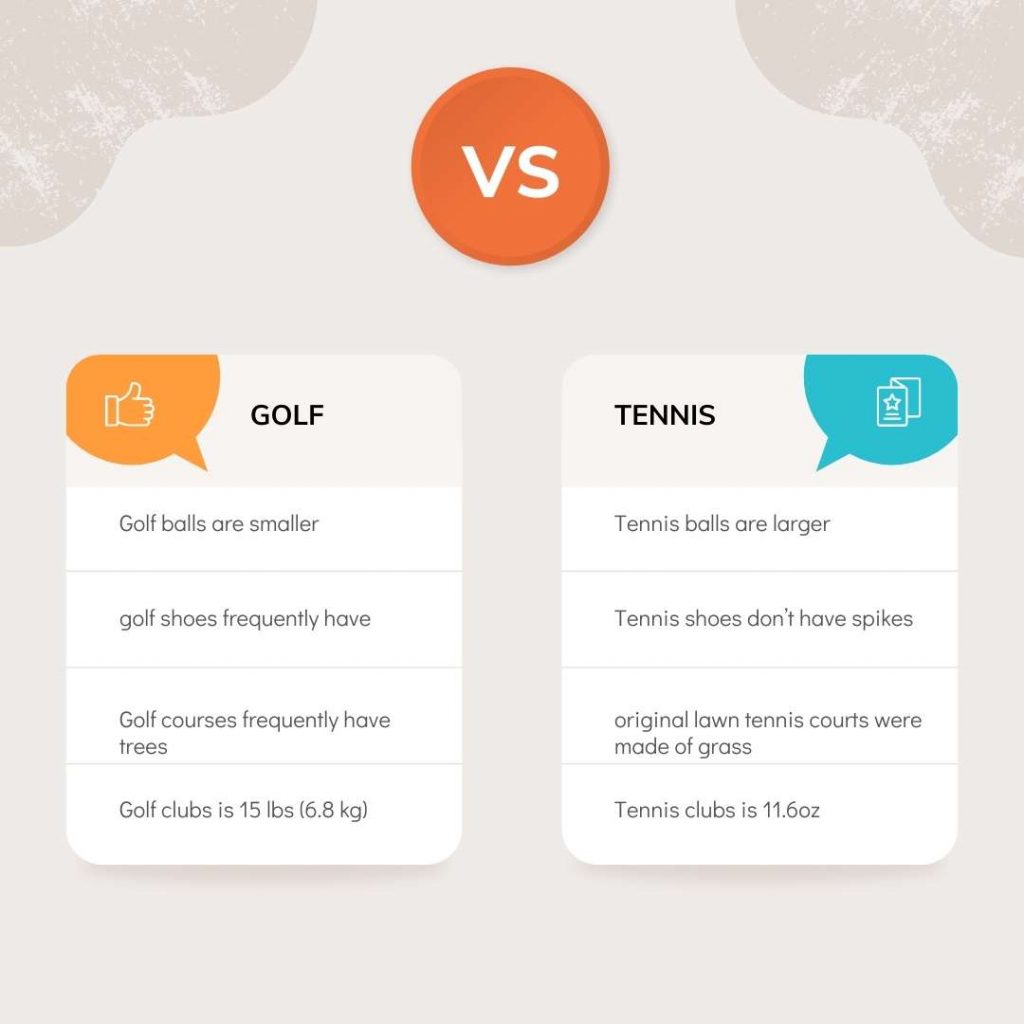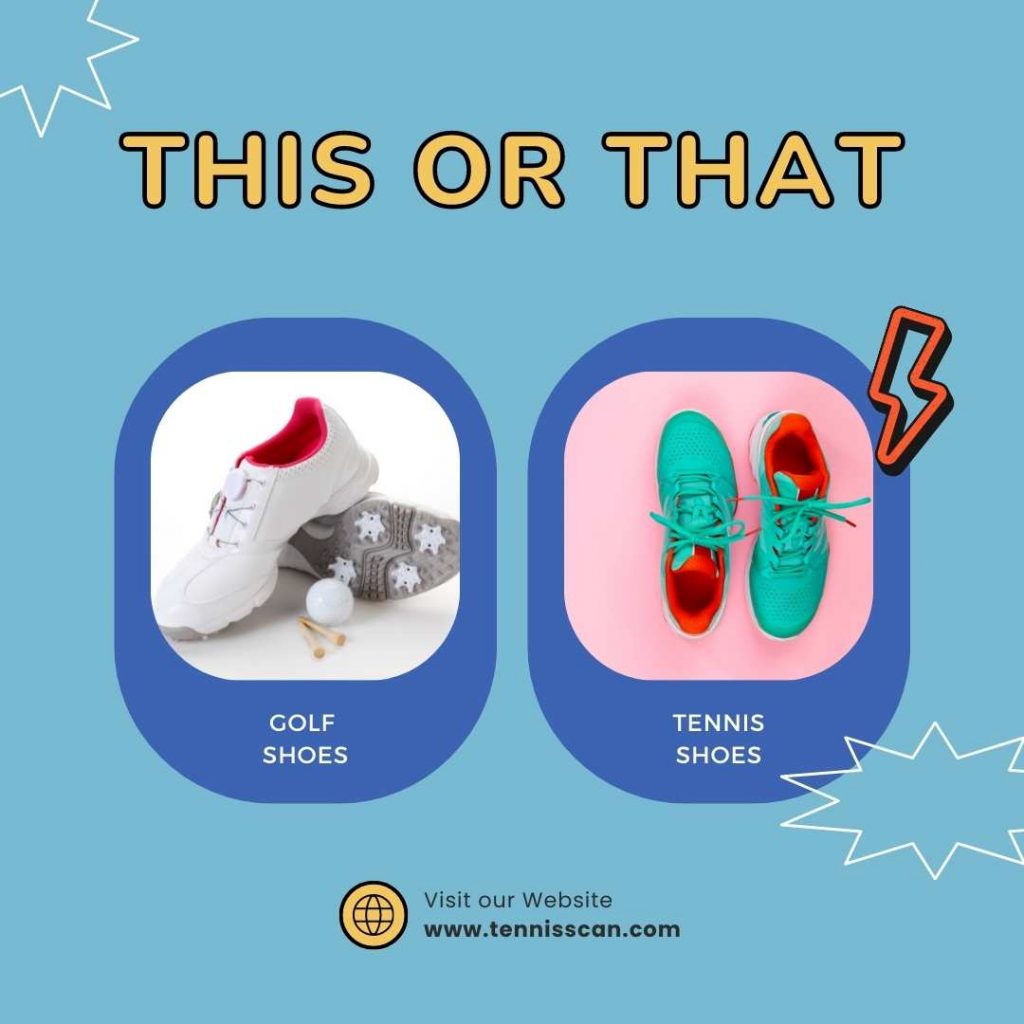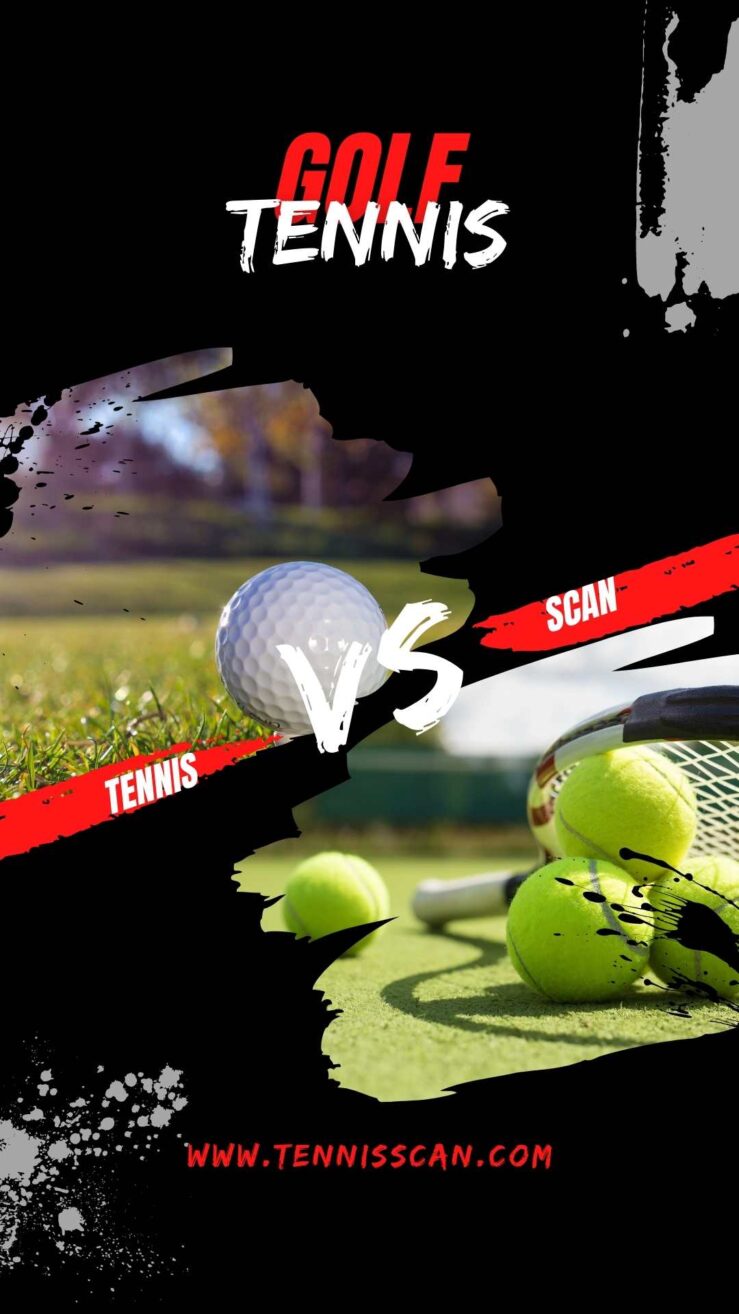Considering that golf is a club sport and tennis is a racquet sport, it’s surprising how many people want to know how the two differ. What distinguishes golf vs. tennis, then? Tennis requires two players to play, whereas golf may be played solo. Tennis is also more physically demanding, whereas golf is more intellectually demanding.
They aren’t similar to tennis and badminton because the key distinctions are extremely significant. That is not to argue that these days you can’t be a top golfer without being in excellent shape. Professional golfers obviously focus on their technique, hit the gym, and probably check their nutrition if they can routinely blast the ball over 300 yards.
Golf vs. Tennis
Tennis requires a lot of speed, strength, and technique, but it also requires a lot of mental toughness. Take a look at Djokovic, Nadal, and Federer’s domination over the years. They obviously understand how to concentrate and handle pressure during important games.
Compared to tennis, golf has a significantly stronger mental component. If you simply want to be fit and calm on Sunday, you can choose golf vs. tennis, or you can combine the two, or you can start playing golf more frequently.
So what distinguishes a top golfer? And what qualities are necessary to develop into a great tennis player? Let’s examine this in greater detail.
Exercise:
Regardless of the sport you do, going around outside in the sunshine is generally healthy for the body and the soul. Overall, tennis is a better aerobic activity. Your pulse rate has been elevated for a few minutes due to the tennis court’s continual action. You may work up a sweat with even a simple back-and-forth rally with pals.
Golf, on the other hand, is easier on the joints, but with time, repetitive motion can cause harm. Some golfers barely move at all as they move back and forth between the golf cart and the green. If you want to get the most out of your exercise, consider walking the course instead of taking the cart.
Expense
There is no question that playing golf daily costs more money than playing tennis. There are many public tennis courts available. You only need tennis equipment and athletic clothing to get started. Spending is slightly higher when playing golf.
Even open enrollment programs demand a membership fee. Additionally, golf clubs are not inexpensive. If you enjoy the sport, the cost should not deter you. For more advice on how to enjoy the sport without breaking the bank, look at our guide on how to play golf on a tight budget.
Talent
To excel at any sport, practice is a need. Tennis and golf are similar. What you need to practice to hone your expertise makes a difference. Tennis demands refining strokes from all angles, but golf only requires mastering one motion.
Tennis also calls for just a little more talent in terms of appropriate footwork and quick reflexes to reach the ball in time. And they are only the physical components. When playing golf, there are thousands of distinct factors that might affect how the ball moves over the course.
Age
Interestingly, both sports are lifelong activities. Both activities are relatively light on the joints, so you can start playing when you’re young and keep playing well into your senior years. Both activities are ideal for the entire family.
What could be better than showing the kids how to swing on their first trip to the tennis court or golf course? These activities are ideal for playing with the family while on vacation. Tennis and golf facilities may be found at many hotels and popular tourist destinations, allowing you to unwind while having fun with the family.
Read more about: Difference Between Tennis vs Golf Elbow
Can you still mess with golf if you play tennis?
There are certain similarities between swinging a tennis racquet and a golf club, especially for forehand and backhand groundstrokes, despite the differences between the two sports. The American Junior Golf Association claims that hitting forehands aids in the development of the body’s rotational strength and movement, which is analogous to a golf swing.
Golf backhands can help you build strong whip movement on your strokes and slow down the golf swing after you make contact. The serve is the only part of tennis that can interfere with your golf swing. After tossing the ball, some tennis players truly arch their backs, strengthening the spine.
To avoid this in your golf swing, though, you must ensure that you are properly positioned by bending your upper body slightly forward at the address position.
Equipment Differences
Let’s have a look at which equipment is different in both sports:

Racquet/Club
The grip, shaft, and clubhead are the three basic parts of a golf club. The grip, formed of rubber or synthetic rubber materials, is where you release your grasp. Steel, stainless steel, aluminum, carbon fiber, graphite, and reinforced epoxy are just a few of the materials that can be used to create the club’s shaft.
Shafts made of titanium are also present. Steel, graphite, carbon fiber, or titanium is all acceptable materials for clubheads because they are frequently similar to shaft materials. Tennis clubs typically weigh 11.6oz (330g), which is a little bit more than tennis racquets.
The average weight of a set of golf clubs is 15 lbs (6.8 kg). Handle, frame, and strings make up a tennis racquet’s three-component structure. Tennis replacements and overgrips are available in both leather and synthetic materials.
The tennis racquet’s frame, or body, is where the strings and grip are attached. Aluminum, the least expensive alternative, or superior materials like graphite, carbon fiber, fiberglass, kevlar, or titanium are used to make tennis frames.
Balls
Tennis and golf balls differ in that the former is hollow and larger, while the latter is smaller and tougher. A tennis ball, on either side, is softer, larger, and hollow inside that may either be filled with pressure or not.
Golf balls are smaller and lighter than tennis balls, with a minimum diameter of 1.68′′ (4.26cm) and a maximum weight of 1.62oz (45.9g). The core of the golf ball, which is frequently constructed of rubber, is the first component of the ball’s construction.
Understanding that these cores are divided into three categories—80, 90, and 100—is crucial. Contrary to popular belief, the ball is covered with either Balata or Surlyn cover and does not finish at the core.
Balata’s rubber-like cover gives the ball a soft, control-focused feel. Since Surlyn covers are made for distance and are also less expensive, they are more suited for novices. For more experienced players, balata covers.
Tennis balls are larger and heavier than golf balls, measuring 2.57′′ to 2.7′′ (6.52cm–6.85cm) in diameter and weighing between 1.975oz and 2.095oz (55.9g–59.4g). Tennis balls are constructed of a rubber shell with wool felt covering, though they can alternatively be made of synthetic materials. Knowing that tennis balls are pressured and inflated is essential.
Shoes

Tennis shoes don’t have spikes underneath them, although golf shoes frequently have, which is the fundamental distinction between the two types of footwear. Tennis shoes, as opposed to golf shoes, have a greater emphasis on lateral support and cushioning.
While not playing tennis, you can also get boots and sandals in addition to golf shoes. The grip on the golf course is the most crucial aspect of golf shoes. The majority of shoes have very large spikes on the bottom because of this; however, there are also models without them.
Due to the quick side-to-side and back-to-front motions, tennis shoes require a lot of support, thus your ankles must be protected. Tennis shoes are also available with more cushioning, particularly on the toecaps because of the rapid stops.
Court
Golf courses come in varied sizes since they are all created differently and have unique holes with different distances and hazards. A typical golf course has 18 holes, starting with hole 1 and going through holes 2, 3, 4, and 18, respectively.
The golfer who completes the course with the fewest total strokes wins the match. The grass is a golf course’s primary construction material, as you know. Sand and water are two more substances that are employed as hazards.
Golf courses frequently have trees, bushes, rocks, pits, bunkers, and other features that add to the game’s beauty and intrigue. Tennis courts come in three different varieties: hard, clay, and grass. Clay courts are the next most popular type of court after hard courts.
The original lawn tennis courts were made of grass, but due to the heavy maintenance requirements, they are less common today. The simplest to maintain are hard courts, which call for hard rather than ordinary duty balls because they can endure the abrasive surface.
If you want to play on grass, you should buy grass court shoes since they contain spikes on the soles. Clay courts are perfect for normal duty balls. Tennis courts aren’t small, but compared to a baseball field, they could appear so. Tennis courts are 77.11 feet (23.77 meters) long and 27 feet (8.23 meters) broad.

FAQ’S
Tennis may be a fantastic activity for anyone, young or old. You will notice a quicker growth of the torso’s speed since the rotational motions of the forehand and backhand in the sport improve the feel of your golf swing.
About 20–25 million people belong to golf clubs in the United States. This essentially stays static most of the time. Tennis has no chance of defeating it. About 26 million Americans and 18 million tennis players respectively played golf and tennis in 2015.
Tennis is more physically demanding to play. On paper, it seems like the cerebral aspect of golf is stronger. Your thoughts immediately shift to missed putts after a missed forehand. While a round of golf lasts four hours, a match of tennis lasts two hours longer.
There are a number of reasons why people might initially find it difficult to develop their golfing abilities. They play while sitting stationary, which is one of these reasons. Even those of us who used to enjoy golf find tennis challenging since the tennis balls are still in motion when players strike them.
